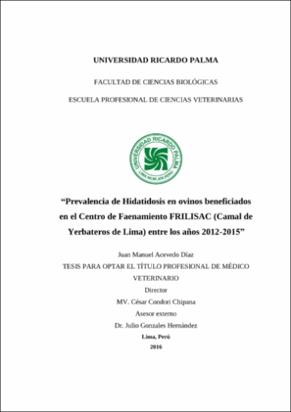Prevalencia de Hidatidosis en ovinos beneficiados en el Centro de Faenamiento FRILISAC (Camal de Yerbateros de Lima) entre los años 2012-2015
Resumen
El presente trabajo tuvo como objetivo principal determinar la prevalencia de Hidatidosis ovina en el centro de Faenamiento FRILISAC (Camal de Yerbateros de Lima) durante los años 2012-2015 y como objetivos específicos determinar la prevalencia mensual y la prevalencia según procedencia, así como las pérdidas económicas producidas. El trabajo consistió en una investigación cuantitativa con diseño Retrospectivo, Descriptivo y Analítico. El material de estudio consistió en el análisis de las fichas de registro de beneficio mensual según especie, sexo y procedencia y del consolidado mensual de decomiso de órganos según especie. Se evaluó un total de 344073 ovinos, de ambos sexos y edades, procedentes de los departamentos de Lima, Ayacucho, Ica y Arequipa, registrados en fichas correspondientes a los años 2012-2015. La prevalencia total de Hidatidosis ovina obtenida durante los cuatro años de estudio fue de 0,32%. Los meses donde más se presentó la Hidatidosis ovina marzo, abril, mayo y diciembre. El departamento donde se obtuvo la mayor tasa de prevalencia fue el departamento de Ayacucho seguido por Lima e Ica donde se obtuvieron prevalencias más bajas, en el departamento de Arequipa no se obtuvo prevalencia alguna durante los años de estudio. El órgano más parasitado fue el pulmón. La pérdida económica total por el decomiso de órganos durante los cuatro años fue de US$ 1, 541,42 dólares. Los resultados obtenidos demuestran que probablemente se están realizando programas de control por parte de los ganaderos para evitar que sus animales contraigan el parásito, por lo cual existiría un riesgo menor para la salud animal y humana en los departamentos evaluados.The present work had as main objective to determine the prevalence of ovine Hidatidosis in the center of Slaughtering FRILISAC (slaughterhouse of Herbalists of Lima) during 2012-2015 and as specific objectives to determine the monthly prevalence and provenance prevalence, as well as economic losses produced. The work consisted in a quantitative research with retrospective, descriptive and analytical design. The study material consisted of monthly benefit record sheets according to species, sex and origin and monthly consolidated of organ confiscation by species. Was evaluated A total of 344,073 sheep, of both sexes and ages, from the departments of Lima, Ayacucho, Ica and Arequipa, registered in record sheets corresponding to the years 2012 to 2015. The overall prevalence of ovine Hidatidosis obtained during the four years of study was 0.32%. The months that presented the highest prevalences of ovine Hidatidosis were march, april, may and december. The department where the highest rates of prevalence were obtained was Ayacucho followed by Lima and Ica where the lowest prevalences were obtained, in the department of Arequipa was obtained any prevalence during the study. The most parasitized organ was the lung. The total economic losess for the confiscation of organs during the four years was US $ 1, 541.42 dollars. The obtained results demonstrate that there is a probably control by farmers to keep their animals from contracting the parasite, so there is a low risk for animal and human health in the departments of ovine tested.
Colecciones
- Medicina Veterinaria [83]


